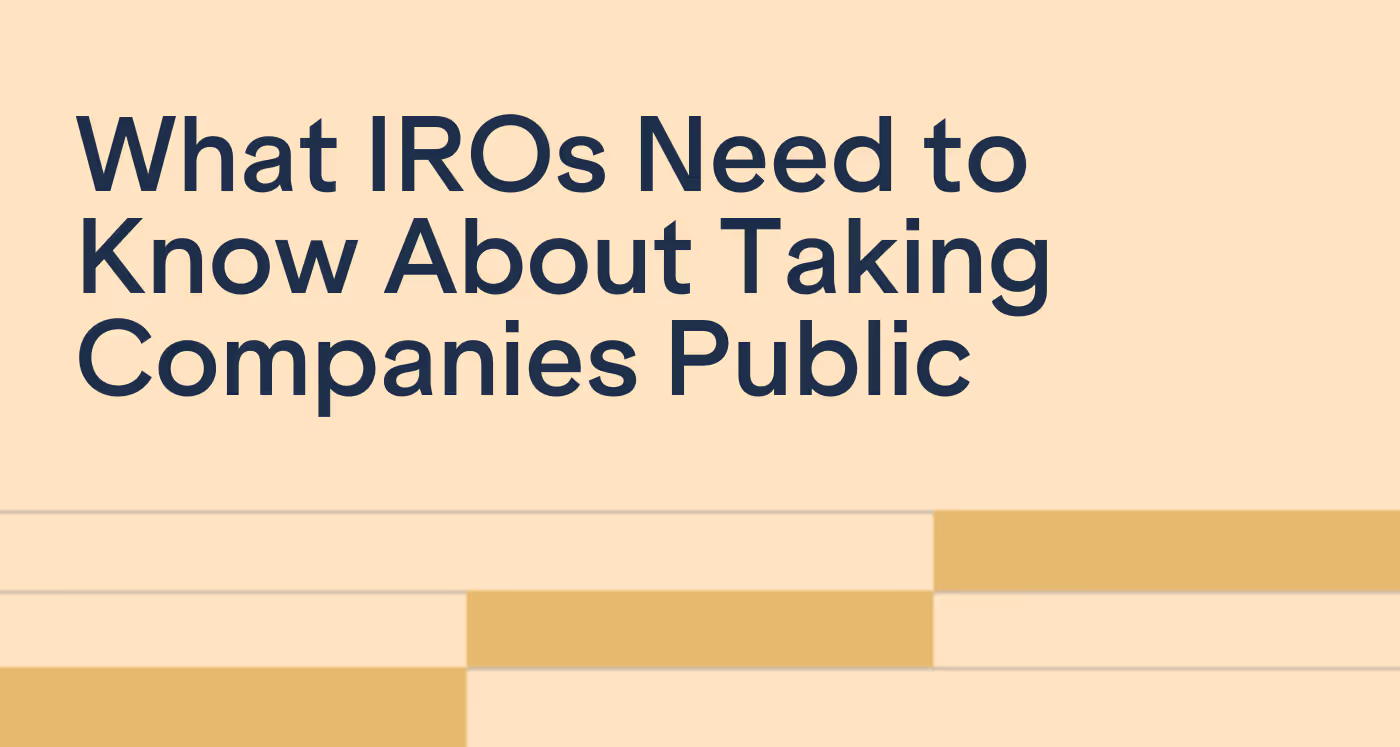
How to Build Effective Investor Targeting and Outreach Strategies for Small-Mid-Cap Companies
Learn how seasoned IR veterans are executing targeting strategies for small-mid-cap companies.

Shareholder monitoring is at the crux of many investor relations strategies, yet for many IROs there’s a staggering amount of missing data. NOBOs, or Non Objecting Beneficial Owners, may comprise a significant percentage of shares, however only a small percentage of IROs are tracking NOBO data regularly. While it has been a time-consuming process to obtain and use data in NOBO lists in the past, these days it’s easier than ever to integrate NOBOs into your IR strategy. This article will cover the difference between Objecting and Non-Objecting Beneficial Owners, how to use NOBOs to lower your cost of capital, encourage shareholders to vote, how NOBOs can help you fine tune your company story, and how to efficiently utilize NOBO data.
At its core, Objecting Beneficial Owners (OBOs) and NOBOs are quite similar. Beneficial owners are shareholders who enjoy the benefits of share ownership without necessarily holding the title to the shares. For example, a beneficial owner might own shares through a brokerage which would hold the title to the shares. Objecting beneficial owners, or OBOs, are shareholders who object to having their personal information shared with issuers. NOBOs on the other hand do not object to sharing their personal information with issuers, and are open to being contacted. Issuers can get a list of NOBO shareholders directly from Broadridge, their transfer agent, and as of recently, directly through Irwin.
While OBOs may seem like a black hole in your investment strategy, they can still help you glean insights about your shareholder base. For instance, if you can determine that OBOs hold 25% of your shares, you know that 75% of shares are identifiable. With 75% confidence in who your shareholders are, you can make strategic decisions to win over similar investors.
There are many benefits to understanding who your NOBO holders are. It’s easier than ever to access this mysterious segment of shareholders and develop a strong relationship. NOBOs can be nurtured into valuable long term holders, can be encouraged to vote favourably, and can offer a wealth of information about the reasons people are buying or selling your company’s shares. All of these strategies can help you lower your cost of capital.
One of the main advantages of shareholder monitoring is that a positive issuer-shareholder relationship can result in longer term shareholders that support a company's share price. Research has shown it is 9x easier to sell more shares to an existing shareholder than it is to find a first time buyer. This holds true for both institutional investors and retail investors. One way to use this strategy effectively is to help line up buyers and sellers; instead of shares hitting the open market, a coordinated sale can keep your share price stable. Additionally, word of mouth referrals from satisfied and engaged shareholders can be tremendously beneficial for long term growth.
By developing a positive relationship with your NOBO holders you can also uncover some of the key reasons independent investors choose to buy your stock. The ability to identify and reach out to NOBO holders gives you an unprecedented amount of information about who is buying your stock and why. In a time when retail investors are becoming increasingly sophisticated and coordinated, you’ll want every advantage you can get.
.avif)
While beneficial owners don’t vote directly on their shares, they can still direct their broker’s votes through proxy. This is an excellent opportunity to leverage your relationship with NOBOs to encourage them to direct their votes favourably. In a situation where activists are pursuing a position with your board, having your NOBOs in your good graces can help you influence the vote in your favour, especially if beneficial owners hold a majority of your shares.
With their contact data at your disposal, it is easy to distribute information to NOBOs before important votes. Irwin user Jamal Baksh, CFO of Constellation Software Inc, recalls a situation prior to using Irwin where he had to mitigate the impact of an activist on the board.
To identify key voting shareholders, he had to browse through his email and other documents and search for their contact information. Proper shareholder monitoring would have minimized the amount of time this took; for a company with sufficient retail shareholders, having the data from a NOBO list at your disposal can substantially impact the outcome of a vote.
“Prior to using Irwin, everything I was doing was ad hoc, I was manually going through Outlook to find out who investors were. We had an activist come after us, so I had to deal with that through email and finding shareholders. I knew the situation wasn’t optimal. ”
- Jamal Baksh, CFO of Constellation Software Inc
Click here to learn more about how Jamal uses Irwin to monitor and manage investor activity.
Another key benefit of analyzing your NOBO list is the sheer wealth of information it provides about who purchases your stock and why. On its own, a NOBO list can be used to glean key demographic trends about shareholders. You may discover trends in age, geography, purchasing power, and other factors that can help you tailor your investor story. It could even give you leverage when pitching to be included in new funds.
On top of all the quantitative data a NOBO list provides, you also have the opportunity to get qualitative data from your NOBO holders directly. With their contact information at your disposal, you have the chance to poll NOBO holders for the reasons they are interested in your stock. This gives you unprecedented insight into where your investor marketing efforts are effective and the general perception of your brand. You can directly ask about what they use as sell or buy signals. None of these insights are readily accessible without some form of shareholder monitoring, and a NOBO list is the only way to get data regarding beneficial owners.
You can order your company’s NOBO list from Broadridge or through an affiliated service provider like Irwin. The benefit of ordering your NOBO list through Irwin is that the data will automatically be parsed and formatted into a tidy spreadsheet and your IR CRM, allowing you to browse through NOBO holders and access key information quickly. Mike McAllister, VP Investor Relations at Sierra Metals Inc., describes Irwin’s NOBO solution as follows:
"Simply put, without something in place like Irwin's NOBO Solution, you're missing a large part of your shareholder base. You don't even know that they're there - you're missing opportunities for people who are willing to buy or increase their positions to support your stock.
If you've got an upcoming financing or important announcement, you are missing people to reach out to. So while you may think you understand who your shareholders are, you really are missing a large portion of your actual shareholder base."
.avif)
In the past it has been difficult or cumbersome to manage a NOBO list; as such, many IROs ignored it. It is now both possible and practical to order and update NOBO lists regularly with new and improved services. The ability to strengthen relationships with investors, increase favourable board participation, and obtain NOBO data all have the potential to lower your cost of capital strategically, and should not be ignored in a robust investor relations program.
Get your NOBO lists uploaded directly into your investor database.

Learn how seasoned IR veterans are executing targeting strategies for small-mid-cap companies.

Elizabeth Librizzi breaks down the secrets of buy-side corporate access to help investor relations professionals utilize buy-side firms.

What IROs Need to Know About Taking Companies Public: Insights from award winning investor relations thought leader Catherine Buan.